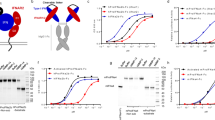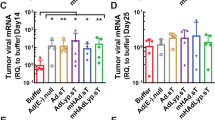Abstract
Type I interferons (α/β) have significant antitumor activity although their short half-life and systemic side effects have limited their clinical utility. An alternative dosing schedule of continuous, low-level delivery, as is achieved by gene therapy, rather than intermittent, high concentration pulsed-dosing, might avoid the toxicity of interferon while maintaining its antitumor efficacy. We have tested a gene therapy approach in murine tumor models to treat malignancies that have shown responsiveness to interferon in clinical trials. The tumor cell lines used were moderately sensitive to the direct effects of human interferon-β (hIFN-β) in vitro. For in vivo testing, systemic delivery of hIFN-β was generated following liver-targeted delivery of adeno-associated virus (AAV) vector carrying the hIFN-β transgene. This prevented engraftment of subcutaneous human gliomas, and orthotopic, localized (intrarenal) and disseminated (primarily pulmonary) human renal cell carcinomas; and caused regression of established tumors at these sites. In a syngeneic, immunocompetent model of melanoma, AAV IFN-β treatment limited subcutaneous tumor growth and prevented disseminated disease. A significant decrease in mean intratumoral vessel density was demonstrated in hIFN-β-treated tumors, suggesting that in addition to a direct tumoricidal effect, the antitumor efficacy of AAV IFN-β in this study was due to its ability to inhibit angiogenesis.
This is a preview of subscription content, access via your institution
Access options
Subscribe to this journal
Receive 12 print issues and online access
$259.00 per year
only $21.58 per issue
Buy this article
- Purchase on Springer Link
- Instant access to full article PDF
Prices may be subject to local taxes which are calculated during checkout






Similar content being viewed by others
Accession codes
Accessions
GenBank/EMBL/DDBJ
References
Isaacs A, Lindenmann J, Valentine RC . Virus interference. II. Some properties of interferon. Proc R Soc Lond B Biol Sci 1957; 147: 268–273.
Pfeffer LM, Dinarello CA, Herberman RB, Williams BR, Borden EC, Bordens R et al. Biological properties of recombinant alpha-interferons: 40th anniversary of the discovery of interferons. Cancer Res 1998; 58: 2489–2499.
Sondak VK . How does interferon work? Does it even matter? Cancer 2002; 95: 947–949.
Dranoff G . Cytokines in cancer pathogenesis and cancer therapy. Nat Rev Cancer 2004; 4: 11–22.
Stark GR, Kerr IM, Williams BR, Silverman RH, Schreiber RD . How cells respond to interferons. Annu Rev Biochem 1998; 67: 227–264.
Belardelli F, Ferrantini M, Proietti E, Kirkwood JM . Interferon-alpha in tumor immunity and immunotherapy. Cytokine Growth Factor Rev 2002; 13: 119–134.
Dvorak HF, Gresser I . Microvascular injury in pathogenesis of interferon-induced necrosis of subcutaneous tumors in mice. J Natl Cancer Inst 1989; 81: 497–502.
Slaton JW, Perrotte P, Inoue K, Dinney CP, Fidler IJ . Interferon-alpha-mediated down-regulation of angiogenesis-related genes and therapy of bladder cancer are dependent on optimization of biological dose and schedule. Clin Cancer Res 1999; 5: 2726–2734.
Dinney CP, Bielenberg DR, Perrotte P, Reich R, Eve BY, Bucana CD et al. Inhibition of basic fibroblast growth factor expression, angiogenesis, and growth of human bladder carcinoma in mice by systemic interferon-alpha administration. Cancer Res 1998; 58: 808–814.
Izawa JI, Sweeney P, Perrotte P, Kedar D, Dong Z, Slaton JW et al. Inhibition of tumorigenicity and metastasis of human bladder cancer growing in athymic mice by interferon-beta gene therapy results partially from various antiangiogenic effects including endothelial cell apoptosis. Clin Cancer Res 2002; 8: 1258–1270.
von Marschall Z, Scholz A, Cramer T, Schafer G, Schirner M, Oberg K et al. Effects of interferon alpha on vascular endothelial growth factor gene transcription and tumor angiogenesis. J Natl Cancer Inst 2003; 95: 437–448.
Einhorn S, Grander D . Why do so many cancer patients fail to respond to interferon therapy? J Interferon Cytokine Res 1996; 16: 275–281.
Salmon P, Le Cotonnec JY, Galazka A, Abdul-Ahad A, Darragh A . Pharmacokinetics and pharmacodynamics of recombinant human interferon-beta in healthy male volunteers. J Interferon Cytokine Res 1996; 16: 759–764.
Feldman AL, Libutti SK . Progress in antiangiogenic gene therapy of cancer. Cancer 2000; 89: 1181–1194.
Nguyen JT, Wu P, Clouse ME, Hlatky L, Terwilliger EF . Adeno-associated virus-mediated delivery of antiangiogenic factors as an antitumor strategy. Cancer Res 1998; 58: 5673–5677.
Kaplitt MG, Leone P, Samulski RJ, Xiao X, Pfaff DW, O’Malley KL et al. Long-term gene expression and phenotypic correction using adeno-associated virus vectors in the mammalian brain. Nat Genet 1994; 8: 148–154.
Herzog RW, Hagstrom JN, Kung SH, Tai SJ, Wilson JM, Fisher KJ et al. Stable gene transfer and expression of human blood coagulation factor IX after intramuscular injection of recombinant adeno-associated virus. Proc Natl Acad Sci USA 1997; 94: 5804–5809.
Streck CJ, Zhang Y, Miyamoto R, Zhou J, Ng CY, Nathwani AC et al. Restriction of neuroblastoma angiogenesis and growth by interferon-alpha/beta. Surgery 2004; 136: 183–189.
Gao GP, Alvira MR, Wang L, Calcedo R, Johnston J, Wilson JM . Novel adeno-associated viruses from rhesus monkeys as vectors for human gene therapy. Proc Natl Acad Sci USA 2002; 99: 11854–11859.
Xiao X, Li J, Samulski RJ . Production of high-titer recombinant adeno-associated virus vectors in the absence of helper adenovirus. J Virol 1998; 72: 2224–2232.
Davidoff AM, Ng CY, Sleep S, Gray J, Azam S, Zhao Y et al. Purification of recombinant adeno-associated virus type 8 vectors by ion exchange chromatography generates clinical grade vector stock. J Virol Methods 2004; 121: 209–215.
Nathwani AC, Davidoff AM, Hanawa H, Hu Y, Hoffer FA, Nikanorov A et al. Sustained high-level expression of human factor IX (hFIX) after liver-targeted delivery of recombinant adeno-associated virus encoding the hFIX gene in rhesus macaques. Blood 2002; 100: 1662–1669.
Davidoff AM, Nathwani AC, Spurbeck WW, Ng CY, Zhou J, Vanin EF . rAAV-mediated long-term liver-generated expression of an angiogenesis inhibitor can restrict renal tumor growth in mice. Cancer Res 2002; 62: 3077–3083.
Weidner N, Folkman J, Pozza F, Bevilacqua P, Allred EN, Moore DH et al. Tumor angiogenesis: a new significant and independent prognostic indicator in early-stage breast carcinoma. J Natl Cancer Inst 1992; 84: 1875–1887.
Kirkwood JM, Ibrahim JG, Sosman JA, Sondak VK, Agarwala SS, Ernstoff MS et al. High-dose interferon alfa-2b significantly prolongs relapse-free and overall survival compared with the GM2-KLH/QS-21 vaccine in patients with resected stage IIB-III melanoma: results of intergroup trial E1694/S9512/C509801. J Clin Oncol 2001; 19: 2370–2380.
Buzio C, Andrulli S, Santi R, Pavone L, Passalacqua R, Potenzoni D et al. Long-term immunotherapy with low-dose interleukin-2 and interferon-alpha in the treatment of patients with advanced renal cell carcinoma. Cancer 2001; 92: 2286–2296.
Tanabe T, Kominsky SL, Subramaniam PS, Johnson HM, Torres BA . Inhibition of the glioblastoma cell cycle by type I IFNs occurs at both the G1 and S phases and correlates with the upregulation of p21(WAF1/CIP1). J Neurooncol 2000; 48: 225–232.
Lu W, Fidler IJ, Dong Z . Eradication of primary murine fibrosarcomas and induction of systemic immunity by adenovirus-mediated interferon beta gene therapy. Cancer Res 1999; 59: 5202–5208.
Choi EA, Lei H, Maron DJ, Mick R, Barsoum J, Yu QC et al. Combined 5-fluorouracil/systemic interferon-beta gene therapy results in long-term survival in mice with established colorectal liver metastases. Clin Cancer Res 2004; 10: 1535–1544.
Hendren SK, Prabakaran I, Buerk DG, Karakousis G, Feldman M, Spitz F et al. Interferon-beta gene therapy improves survival in an immunocompetent mouse model of carcinomatosis. Surgery 2004; 135: 427–436.
Yoshida J, Mizuno M, Wakabayashi T . Interferon-beta gene therapy for cancer: Basic research to clinical application. Cancer Sci 2004; 95: 858–865.
Qin XQ, Beckham C, Brown JL, Lukashev M, Barsoum J . Human and mouse IFN-beta gene therapy exhibits different anti-tumor mechanisms in mouse models. Mol Ther 2001; 4: 356–364.
Acknowledgements
This work was supported by The Alliance for Cancer Gene Therapy, as well as grants from the Assisi Foundation of Memphis 94-000, Grant #IRG-87-008-09 from the American Cancer Society, Cancer Center Support CORE Grant, P30 CA 21765 and American Lebanese Syrian Associated Charities (ALSAC). We thank Dorothy Bush for her assistance with immunohistochemistry and Stacey Glass for her assistance with ultrasonography.
Author information
Authors and Affiliations
Corresponding author
Rights and permissions
About this article
Cite this article
Streck, C., Dickson, P., Ng, C. et al. Antitumor efficacy of AAV-mediated systemic delivery of interferon-β. Cancer Gene Ther 13, 99–106 (2006). https://doi.org/10.1038/sj.cgt.7700878
Received:
Revised:
Accepted:
Published:
Issue Date:
DOI: https://doi.org/10.1038/sj.cgt.7700878
Keywords
This article is cited by
-
Interferon-β Sensitivity of Tumor Cells Correlates With Poor Response to VA7 Virotherapy in Mouse Glioma Models
Molecular Therapy (2012)
-
Enhancers of Adeno-associated Virus AAV2 Transduction via High Throughput siRNA Screening
Molecular Therapy (2011)
-
Neural Stem Cell-based Gene Therapy for Brain Tumors
Stem Cell Reviews and Reports (2011)
-
NF-κB activation mediates resistance to IFNβ in MLL-rearranged acute lymphoblastic leukemia
Leukemia (2010)
-
Using lentiviral vectors for efficient pancreatic cancer gene therapy
Cancer Gene Therapy (2010)



